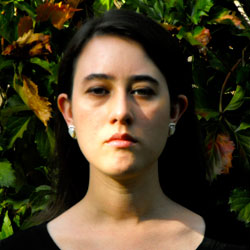I want to be the lemons in the bowl
on the cover of the magazine. I want
to be round, to be yellow, to be pulled
from branches. I want to be wax, to be
white with pith, to be bright, to be zested
in the corners of a table. I want you
to say my name like the word: lemon.
Say it like the word: limón. Undress me
in strands of rind. I want my saliva to be
citrus. I want to corrode my husband’s
wedding ring. I want to be a lemon
with my equator marked in black ink –
small dashes to show my shape: pitted & convex.
Notes on the Poem
We can be captivated by a poem in so many ways, at so many levels, from appreciation of the craft, the structural aspects, the technical wizardry, to engagement in the thematic, be it topical or historical, to astonishment at words on the page exuding surprising emotional heft. How about the exhilaration produced by words evoking potent sensory impressions? Let's look (and engage other senses, for that matter) at how a crisp selection from Natalie Scenters-Zapico's 2020 Griffin Poetry Prize shortlisted collection Lima :: Limón achieves this. Among the many Griffin Poetry Prize shortlisted works we've celebrated with Poem of the Week selections, we've been blessed with many that wield language in ways that connect vividly with readers' senses. Examples include "When You Look Up" by Jan Zwicky, "At Ursula's" by Derek Mahon and "Poppies" by Yusef Komunyakaa. Scenters-Zapico's tantalizing poem "Lima Limón :: Infancia" joins that most satisfying company. As the poem opens with "I want to be the lemons in the bowl on the cover of the magazine" we experience a burst of brightness imagining that magazine cover, made more brilliant by the likelihood that the image is shining from clean, glossy paper and is somewhat idealized in presentation. Either the bowl of lemons is accenting some furniture or other decor, or is part of a health, beauty and/or lifestyle article. The poem continues with the vigour of a lemon's colour, scent, taste and texture, with the repeated "I want" punctuating each phrase introducing different features of the fruit. However, from that perfect, glowing initial image, the poem moves from more conventional associations to considerably less so, more unpleasant, more abrasive. The lemon's pith is not one of its most desired components; online cooking advice observes "This part is bitter and can add an unpleasant taste if you include it in a dish by mistake." Zest from the rind, in moderation, is refreshing ... but "in the corners of a table"? When the insistent "I want's" come to "I want to corrode my husband's wedding ring" we realize the poem's narrator may have very pointed reasons for focusing on the thornier attributes of this dichotomous fruit. As the poem closes, we've moved from the breezy early reference to "round" to now reveling in odd, asymmetrical shapes and textures of the often idealized lemon image. The ones on that magazine cover are probably airbrushed, anyhow. But this progression from bright and idealized to disagreeable still venerates the astringent aspects of the lemon. Acknowledging the lemon's acidic power, the poem's narrator and we the readers, willingly welcoming sensory overload, are still nourished and cleansed.
